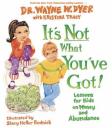Introduction:
Being able to spend money responsibly has become an important characteristic in today’s society. With the economy slowly becoming better, meeting the needs of your life at a cheap price is a necessity. Children learn important aspects of their social life from school and more importantly from their parents. Parents are role models for their children, showing children the proper way to live their lives. In order to achieve great wealth, people must first know how to save money and use their money responsibly.
Summary:
Children understanding the importance of money is an important lesson that must be taught to them early on. The book It’s Not What You’ve Got provides examples of how money should be used and that money does not make you happy. At the beginning of the book, there is a page listing 10 things related to money and how people use money throughout their lives. Each page thereafter talks about one the 10 things mentioned on the first page but in more specific terms. The reasons for certain ideas follow that of society at the moment and also provide information that will help children succeed in life. At the end of the book, the author poses questions related to the children’s lives.
Curriculum Connections:
This book could be used in kindergarten or 1st after going over an economics lesson. It could be used as review for the kindergartens and 1st graders and understanding that they will reconize people make certain choices because they cannot always have what they want and that people get what they want by going to a job and earning money the right way. In addition, it could be used to help reiterate to children that money does not always make you happy. It could help improve children’s social skills on saving money.
Additional Resources:
Economics and Children’s Literature provides a list of additional books that could be used in the classroom when conducting econimic classrooms. This part of the site specifically focuses on the grades k-2.
In order to help students further understand the notion of saving money and then buying things you need, teachers can always set up a classroom economy. Classroom economy provides a lesson plan that teachers can use and the information to help teachers set up their classroom economies.
A good lesson plan on the SOL 2.7 is provided called Tortilla Factory. This specific lesson plan will students better understand the differences between natural resources, human resources, and capital resources.
General Information:
Book: It’s Not What You’ve Got! Lessons for Kids on Money and Abudance
Author: Dr. Wayne W. Dyer and Kristina Tracy
Illustrator: Stacy Heller Budnick
Publisher: Hay House Inc.
Publication Date: 2007
Pages: 32
Grade Range: k-2
ISBN: 9781401918507

